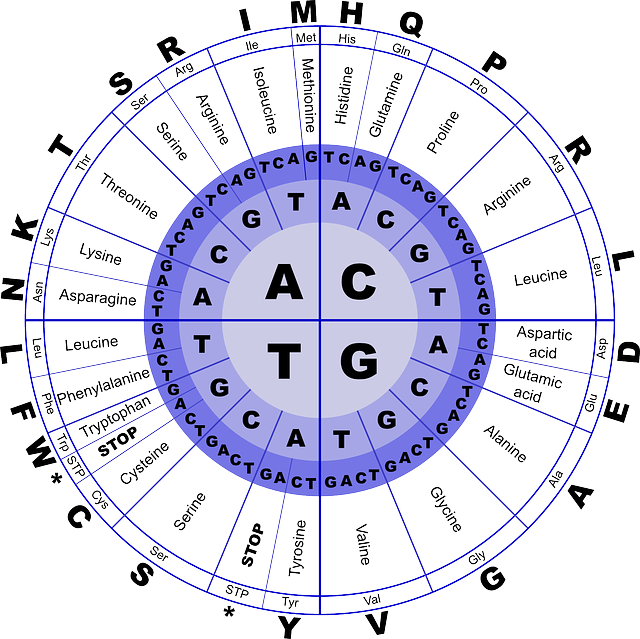Genetic Code
We all know that in every living organism of the world, if they have cellular organization, then DNA acts as genetic material in them. DNA transfers genetic characters from one generation to the next.
But in what form are the genetic messages present in DNA or what is its language called.
Apart from this, how is this genetic language understood?
Also, are the genetic codes the same in all the living beings present in this world or are there any differences among them?
Today we will discuss all these things in detail.
What is genetic code?
All types of organisms, whether they are prokaryotes or eukaryotes (either prokaryotes or eukaryotes), have the same chemical called DNA (Deoxyribonucleic acid) to determine the genetic character.

image source-pixabay
DNA in all living organisms is composed of four types of nitrogenous bases – adenine, guanine, cytosine and thymine, a five-carbon pentose sugar (deoxyribose sugar) and a phosphate.
When they combine, a nucleotide is formed. The sequence of these nucleotides or nitrogenous bases is called genetic code.
When these sequences are copied into RNA, they are called genetic code or genetic code.
Who conceived of the genetic code?
The hypothesis of the genetic code was first given by the scientist George Gamow, according to which the genetic code is a triplet of nucleotide or a triplet of nitrogenous bases.
Means any genetic code is made up of three bases present in DNA, these three bases can be of the same type or can be of different types.
For example, AUG is also the genetic code and is made up of three different nitrogenous bases (adenine, uracil, guanine).
Similarly, UUU is also a genetic code, but all the three nitrogenous bases in it are of the same type.
Note:- It is important to note here that uracil nitrogenous base is present in RNA instead of thiamine.
Which RNA contains the genetic code?
Although we have just talked above that the genetic code is present in DNA, when organisms have to use their genetic message, then the cell does the formation of RNA from DNA.
This RNA is called M-RNA (messenger RNA), because from the name itself we will understand why it is called messenger RNA. Because it copies genetic messages from DNA.
Types of genetic code
George Gamow, the scientist who gave the hypothesis of genetic code or genetic code, explained that since a genetic code is made up of three bases or nucleotides.
And in total, four types of nitrogenous bases are found, so the total number of genetic codes will be 64 types.
It can also be understood in this way.
(4)3 A genetic code is made up of 3 bases, thus the total number of codons (4)3 = 4×4×4 = 64
Who reads or translates the genetic code?
It is copied during m-RNA, and all the genetic codons are present in the m-RNA itself. But to understand and decode or translate it, there is another RNA in the cells, which is called t-RNA (transfer RNA).
t-RNA is a special type of designed RNA, in which anti-codons are present to read and sense the codons.
During transcription, t-RNA identifies genetic codons in m-RNA and apply the correct amino acids during protein formation. In this way the right protein is made, and the information to make it is in the correct form in the DNA.
Salient Features of genetic codons
The main features of the genetic code are as follows –
(1) Genetic codes are triplets – if we look at someone’s, genetic code It is made up of three bases or nucleotides.
(2) Genetic codes degenerate- We know that in total 20 types of amino acids are required for protein formation, but genetic codon is 64 which is more than number of amino acid this is called degeneracy og genetic codon.
(3) Genetic codes are comma less– no comma of any kind is found between two genetic codes.
(4) AUG- is called the starting codon, because it starts the process of protein formation, and AUG codes for the first amino acid called methionine.
(5) Stop Codon- There are three genetic codons that do not code for any type of amino acid. Their names are as follows –
UGA, UAA and UAG However, except for some exceptions, it works like a stop codon in every organism.
(6) Genetic codes are universal – if some exceptions are left, be it a prokaryote cell or a eukaryote cell, genetics code the same type of amino acid everywhere.
For example, if the coding of proline amino acid is done with CCG codon, then every type of cell (prokaryote cell or eukaryote cell) means whether it is bacteria or plant cell or animal cell, everywhere the coding of proline amino acid will be done by CCG codon.
(7) Genetic code is non-overlapped, no codons in m-RNA non-overlaps to each other.
Conclusion
In today’s post, we have understood the following questions related to Genetic code such as-
What is genetic code?
What are the types of genetic code?
What are characteristics of genetic code?
However, any kind of suggestion or update and if you see any mistake, then you must tell us.
We will try our best to update your suggestion or any mistake which happened somewhere in the post.
Thank you very much for giving your valuable time.
If you want to read genetic code in hindi click here
Have a nice online journey.
